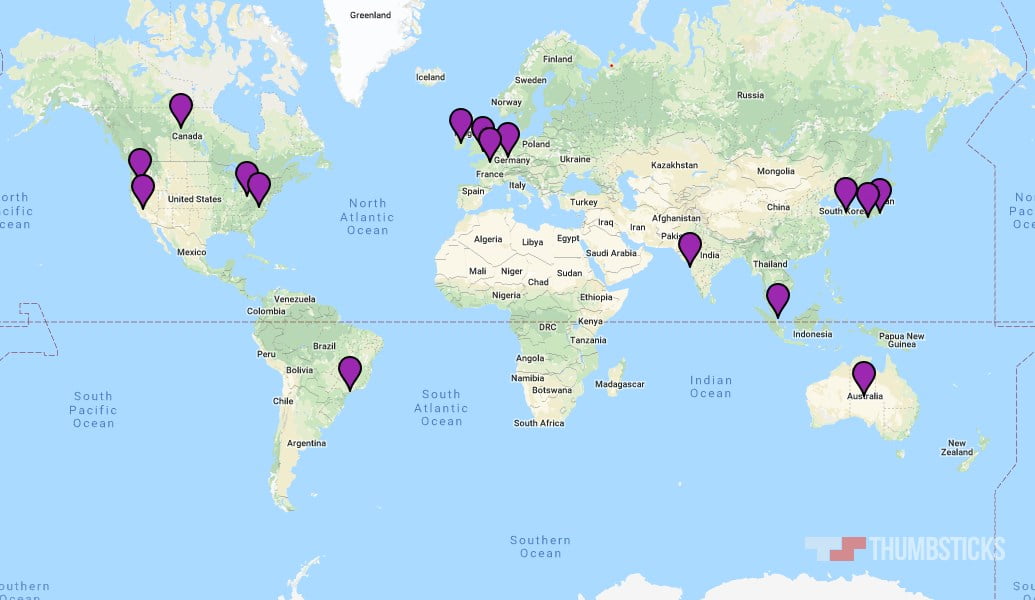If you’re struggling with latency, or just interested in how things work, you might want to know where the Fortnite servers are located.
In the dim, distant past, you needed to know server names or IP addresses to connect to an online game. You’d need to enter them into your client or pick them from an ever-rotating list. Part of the metagame became picking the best servers to play the actual game on.
Pick the right ones and you’ll enjoy lower latency. That (generally) means smoother gameplay. Pick the wrong ones? It’ll be like riding a Segway through Marmite.
One of the benefits of modern video game client-server architecture is the intelligence of it all. Your client will run tests against the available servers and, whichever one has the shortest and most-stable round-trip time for a data packet – known as a ping – will be the one you wind up on. Usually, that’ll be the one that’s geographically closest to you, but if there are infrastructure issues, you might find yourself further afield. Some games – like PUBG, for one – will even try to match players with higher latency together, so at least everyone on a terrible connection is in the same boat.
If you live in a part of the world that’s less well-served, like Africa or the Middle East, players might find they struggle with latency. So here’s a question: where are the Fortnite servers located, exactly?

The short answer is that Fortnite servers are everywhere. Sort of.
The long answer is that Fortnite servers are located in a deliberately distributed set of servers and locations across Amazon’s global public cloud infrastructure, known as Amazon Web Services, or AWS for short.
What is the public cloud?
The longer answer is even more complex.
Where once, you’d connect to a single physical server at a time to play an online game, to play a game of Fortnite you might be connected to several virtual servers at once. There are servers that handle authentication and manage the user database. There are servers for payments and microtransactions. There are load balancers that determine where the player base is most densely packed, and divert new player sessions to other areas.
And then there are the back-end servers you actually play on. You might be connected to authentication servers in one area and back-end servers in another. The beauty of infrastructure like AWS is that all of Amazon’s data centres – that’s large, purpose-built facilities that house the hardware their cloud runs on – are all connected via tens of thousands of miles of private fibre optic cables.
To get anywhere on the internet usually requires dozens of hops, around different routing and service providers until you get to your destination. The more hops you take from source to destination, the higher the latency, generally speaking. But once you’re into Amazon’s cloud infrastructure and onto their private fibre? The connection speed is high, and latency between Amazon’s data centres is incredibly low.
So all you need to do is get into Amazon’s network via your nearest point, then all onward connectivity to Fortnite servers and services from there should be pretty speedy. This sort of global, interconnected cloud infrastructure is exactly the same sort of technology that will power Google’s Stadia streaming service.
The other benefit of cloud-based infrastructure is that Epic can expand the Fortnite server pool on demand, without having to wait weeks for new hardware to be delivered. It just pays for what it consumes on a monthly basis, and those costs expand or contract with the amount of processing capacity, network bandwidth, and data storage the game’s players consume.
So now we understand what sort of infrastructure Fortnite is running on, and we have a rudimentary understanding of how public cloud infrastructure works. (And if you want to know more, hit me up on Twitter. Always happy to talk about this stuff, but trying to keep this piece a bit more general.) What we still don’t know is where the Fortnite servers are physically located – which Amazon data centres host Fortnite servers in which regions?
According to an article in Wired (now behind a paywall, but your first five articles are free) from August 2018, Fortnite servers run from “24 of the 55 availability zones that exist” in AWS. An availability zone, in lay terms, is one of the data centres or groups of infrastructure that makes up an AWS region.
(The US East region, for example, is made up of four availability zones clustered around Dulles airport in Virginia, known in IT circles as ‘Data Centre Alley’. This is because it’s one of the largest fibre optic interconnect locations in the world, so naturally, lots of data centres and service providers, including AWS, have set up shop there.)
To figure out which availability zone you’re connected to in Fortnite, you can use the ping tool in your client. Go to the ‘settings’ menu and then the ‘game’ tab. Then go to ‘matchmaking region’ and you’ll see both your ping response and your server location. (You can also choose to overlay this on your game HUD, if you’re worried about your latency.)
By using this feature, some enterprising sorts have built up a list of Fortnite server locations. This means they can keep a track of Fortnite’s server availability, response times, and track any issues with the game, then publish these tools and stats online. And using one of these tools – pingtestlive.com, which tracks more games than just Fortnite – we’ve built up a list of the Fortnite server locations. (At the time of writing, in May 2019.)
Fortnite server locations
Here’s a map of the Fortnite server locations:

But obviously, those locations aren’t exact. There isn’t a data centre in the middle of Australia – that would be silly! – but we don’t know which of Amazon’s Australian data centres specifically Fortnite is using, so we just slapped it in the middle of the country. Ditto Canada. Here’s the list in full, with some general and some specific locations, based on what we know about the availability zones they sit in:
- Ohio, USA
- Virginia, USA
- California, USA
- Oregon, USA
- Tokyo, Japan
- South Korea
- Osaka, Japan
- Mumbai, India
- Singapore
- Australia
- Canada
- Frankfurt, Germany
- Ireland
- London, UK
- Paris, France
- Sao Paulo, Brazil
And that’s the list, as it stands, in May 2019. You’ll notice a few gaps in coverage – Africa, the Middle East, Eastern Europe, Russia – that mean some players are left with higher latency connections. This is because the “nearest” server for players in Dubai might be Mumbai in India, for example, which is around 2,000km away!
But that’s not the end of the story. While the game continues to be successful and Amazon’s infrastructure grows into new areas, there’s every chance Epic might expand the Fortnite servers into more regions, if they see a significant demand for it.
It’s certainly easy enough to do when you’re running on public cloud infrastructure.






